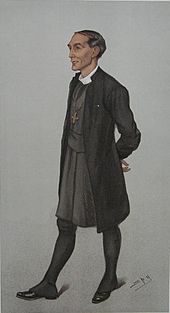Arthur Winnington-Ingram
Stanford-on-Teme, Worcestershire, England | |
|---|---|
| Died | 26 May 1946 (aged 88) Upton-upon-Severn, Worcestershire, England |
| Nationality | British |
| Denomination | Anglican |
| Parents | Edward Winnington-Ingram Louisa Pepys |
| Education | Marlborough College |
| Alma mater | Keble College, Oxford |


Arthur Foley Winnington-Ingram
Early life and career
He was born in the rectory at
He was a private tutor in Europe,
Episcopal career
In 1897, Winnington-Ingram was raised to the
First World War
During the
Winnington-Ingram was renowned as a charismatic preacher and persuasive writer, and he was arguably better known and more influential than either of the archbishops. Examples of his persuasive vocabulary can be traced throughout the War in the monthly London Diocesan Magazine, often quoted in the press: "Now, Jerusalem is a beautiful place, but England is far more beautiful",[14] "We face possibly another year of war, but it is God’s War; it is War for peace; it is a War for all the things which are essential to lasting peace, freedom, respect for national aspirations, international honour and chivalry to the weak",[15] "Great Britain has risen like a tower out of the deep and stands today higher in the opinion of the world than it has since Trafalgar and Waterloo".[16]
For his war work he was
Later life and legacy
On 22 May 1946, Winnington-Ingram was taken ill while playing
Australian sculptor Theodora Cowan created a portrait bust of Dr Winnington-Ingram which "took pride of place" in her one-woman show at London's Grafton Galleries.[21][22]
He is commemorated in some of the street names in
A wide public was familiar with Winnington-Ingram through numerous illustrations of various kinds, including cartoons; the
Works
Unless otherwise indicated, all titles sourced from his sketch in Crockford's Clerical Directory 1938:
- Old Testament Difficulties (1890)
- New Testament Difficulties (1892)
- Church Difficulties (1893)
- Work in Great Cities (1895)
- Messengers, Watchmen, Stewards (1896)
- The Men Who Crucified Christ (1896)
- Friends of the Master (1897)
- Banners of the Christian Faith (1899)
- Popular Objections to Christianity (1899)
- The Afterglow of a Great Reign (1901)
- Under the Dome (1902)
- Addresses in Holy Week (1902)
- Faith of Church and Nation (1904)
- Lenten Addresses (1905)
- The Gospel in Action (1906)
- A mission of the Spirit (1906)
- The Call of the Father (1907)
- The Love of the Trinity (1908)
- Joy in God (1909)
- Into the Fighting Line (1909)
- The Mysteries of God (1910)
- Secrets of Strength (1911)
- The Attractiveness of Goodness (1913)
- The Gospel of the Miraculous (1913)
- A Day of God (1914)
- The Eyes of Flames (1914)
- The Church in time of war (1915)
- The Potter and the Clay (1917)
- Rays of Dawn (1918)
- Victory and After (1919)
- Spirit of Peace (1921)[25]
- Rebuilding the Walls (1922)
- The Spirit of Jesus (1925)
- The Sword of Goliath (1926)
- Some World Problems (1927)
- Holiday Recollections of a World Tour (1928)
- Why am I a Christian? (1929)
- Good News from God (1930)
- What the Cross Means to Me (1934)
- Has God spoken to man? (1934)
- Has the Kingdom of God Arrived? (1935)
- Nine Christian Virtues (1936)
- Every Man's Problems and Difficulties (1937)
- What a Layman Should Believe (1938)
- The Secrets of Happiness (1939)[26]
- Fifty Years' Work in London (1940)[26]
- Secrets of Fortitude (1940)[26]
References
- ^ The Tablet archive — 20 April 1901, pages 24–25 (Accessed 2 July 2015)
- ISSN 0009-658X. Retrieved 2 July 2015 – via UK Press Online archives.
- ^ Oxford DNB — Ingram, Arthur Foley Winnington- (Accessed 2 July 2015)
- ^ Thicknesse, Cuthbert (1959). Wickham Legg, LG; Williams, ET (eds.). Dictionary of National Biography, 1941–1950. Oxford University Press. p. 964.
- ^ Oxford University Calendar 1895, Oxford : Clarendon Press, 1895, p.232.
- Who's Who & Who Was Who. Vol. 1920–2008 (December 2007 online ed.). A & C Black. Retrieved 4 June 2013. (Subscription or UK public library membershiprequired.)
- ^ Dictionary of National Biography, 1941–1950. p. 965.
- ^ History, Oxford House, archived from the original on 5 May 2008.
- ^ Who's Who, 1901
- ^ "No. 27295". The London Gazette. 19 March 1901. p. 1937.
- ^ "No. 27313". The London Gazette. 14 May 1901. p. 3273.
- ISBN 0-19-861379-2.Article by Jeremy Morris.
- ^ London Diocesan Magazine, May, 1915
- ^ London Diocesan Magazine, October, 1914
- ^ London Diocesan Magazine, January, 1916
- ^ London Diocesan Magazine, January, 1918
- ^ Acović, Dragomir (2012). Slava i čast: Odlikovanja među Srbima, Srbi među odlikovanjima. Belgrade: Službeni Glasnik. p. 595.
- ^ "Dr AF Winnington-Ingram". Obituaries. The Times. No. 50462. London. 27 May 1946. col D, p. 6.
- ^ Oxford Dictionary of National Biography, Volume 29. p. 282.
- ^ "Winnington Ingram". Auckland Star. Vol. XXXII, no. 111. 11 May 1901. p. 5.
- ^ Prior, James (11 December 1985). "Theodora Cowan - Chipping away at a career ... and sexism". The Sun (Sydney). p. 49.
- ^ Sturgeon, Graeme (1978). The Development of Australian Sculpture 1788-1975. London: Thames and Hudson. p. 48.
- ^ Bishop Winnington-Ingram Primary School website
- ^ "Arthur Foley Winnington-Ingram - National Portrait Gallery".
- ^ Who Was Who, 1941-1950. A and C Black. 1952. p. 588.
- ^ a b c Who Was Who, 1941-1950. p. 589.
- Spencer Cecil Carpenter, Winnington-Ingram. The biography of Arthur Foley Winnington-Ingram, Bishop of London, 1901-1939 (1949)
- Percy Colson, Life of the Bishop of London: An Authorised Biography; A Tribute on His Jubilee 1885-1935 (1935)
